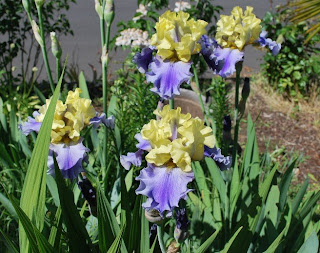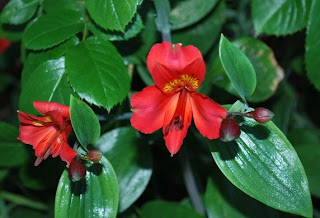Alstroemeria.
Monday, May 25, 2009
What's blooming?
There are flowers everywhere. The dogwood finished, daffodils and tulips are long gone. The next wave is either "late Spring" or "Early summer".
 More of "Edith Wolford" Iris.
More of "Edith Wolford" Iris.
 The "Rustled Rose", grape-scent.
The "Rustled Rose", grape-scent.
 "Tamara" rose. 1st flower.
"Tamara" rose. 1st flower.
 Clematis
Clematis

Alstroemeria.
 Red Poppies. The digital camera doesn't do justice with how red these really are. Seed grown, now in their 7th year.
Red Poppies. The digital camera doesn't do justice with how red these really are. Seed grown, now in their 7th year.
Alstroemeria.
Labels:
alstroemeria,
clematis,
iris,
poppy,
roses
Saturday, May 23, 2009
Iris time.
Thursday, May 14, 2009
Tomato log
Currently the plants in the tomato bed are sulking. There have been several nights as low as the low 40s, last night was 49 degrees. Tomatoes should not be set out until the minimum night temp is above 50. It WAS warmer when I planted them.
My own seedlings in pots are catching up to the purchased ones. The race has begun!
Thinning peaches. Victory over leaf curl!
Peaches and other stone fruits often over-bear. Too many can mean they all fall off, no bearing the following year, and the peaches are too small and not as flavorful It's psychologically difficult to remove peaches, but they are in clusters as thick as grapes, so about 3/4 have to go. I started thinning using a scissors, but finally twisted them off. I probably need to thin some more, but I'll wait to see how these do.
 Before thinning. Peaches are so thick that the stems are obscured. They look like fuzzy grapes.
Before thinning. Peaches are so thick that the stems are obscured. They look like fuzzy grapes.
 After thinning. I quit counting after removing 200 tiny peaches. There are probably still over 150 on the tree. Since these are genetic dwarf peaches, the leaves are much closer together than regular peaches. Plus, the final peaches are smaller. So, I don't think that they need to be thinned to the same distances as regular peaches.
After thinning. I quit counting after removing 200 tiny peaches. There are probably still over 150 on the tree. Since these are genetic dwarf peaches, the leaves are much closer together than regular peaches. Plus, the final peaches are smaller. So, I don't think that they need to be thinned to the same distances as regular peaches.
If I was superstitous I would not declare victory. But we are getting to the end of when leaf curl is a problem. Click on labels below to see what I did, and what they looked like this time last year. It worked! Not only did I not kill the peaches with the plastic bags and spray, but they look great! I have pulled of about 10 leaves with leaf curl, but that's nothing compared to last year. Today I sprayed with neem - not sure if it helps, but they are in with the roses and roses definitely benefit (decreasing aphids and fungal disease)

If I was superstitous I would not declare victory. But we are getting to the end of when leaf curl is a problem. Click on labels below to see what I did, and what they looked like this time last year. It worked! Not only did I not kill the peaches with the plastic bags and spray, but they look great! I have pulled of about 10 leaves with leaf curl, but that's nothing compared to last year. Today I sprayed with neem - not sure if it helps, but they are in with the roses and roses definitely benefit (decreasing aphids and fungal disease)
What's blooming?
Thursday, April 30, 2009
Preventive measure: Tanglefoot for ants and aphids
Every year, I discover ants in the figs. It's not too bad - slice open and wash them out. If you miss a few, the ants have a nice crunchy texture and nutty flavor. However, the ants carry fungal spores, and it seems that the ant-infested figs also spoil before they reach their ultimate sweetness. Every year, I tell myself that "next year" I'll prevent the ant infestation.
Same with the cherries. Every summer, the leaves develop massive black cherry aphid infestations. I suspect that the ants cultivate the aphids. AFTER I see them, I get out the tanglefoot, but by then a lot of damage is done.
So this year WILL BE DIFFERENT! I actually did remember. What's up with that! Tanglefoot is great at stopping the ants from climbing the trees, and no toxic chemicals.
 The instructions state to wrap the tree tightly with plastic, before applying the tanglefoot. I cut wide strips from plastic grocery store bags. These have enough stretch to make snug, bark-tight bands. They also tear quite easily, so there is no risk of girdling the tree with them. They start to deteriorate in about a year, which is time for the new coating.
The instructions state to wrap the tree tightly with plastic, before applying the tanglefoot. I cut wide strips from plastic grocery store bags. These have enough stretch to make snug, bark-tight bands. They also tear quite easily, so there is no risk of girdling the tree with them. They start to deteriorate in about a year, which is time for the new coating.
 I use a disposable plastic knife to apply the Tanglefoot. It's very gooey. Next to impossible to wash out of clothing.
I use a disposable plastic knife to apply the Tanglefoot. It's very gooey. Next to impossible to wash out of clothing.
I applied the same treatment to the pears, apples, cherries, and figs. The reason for also applying to the apples and pears is to reduce spread of disease by aphids.
Same with the cherries. Every summer, the leaves develop massive black cherry aphid infestations. I suspect that the ants cultivate the aphids. AFTER I see them, I get out the tanglefoot, but by then a lot of damage is done.
So this year WILL BE DIFFERENT! I actually did remember. What's up with that! Tanglefoot is great at stopping the ants from climbing the trees, and no toxic chemicals.
I applied the same treatment to the pears, apples, cherries, and figs. The reason for also applying to the apples and pears is to reduce spread of disease by aphids.
Labels:
apple,
cherry,
fig,
Insect control,
pear,
Tanglefoot
Saturday, April 25, 2009
Visitor Update
Backyard Orchard
Despite the Orchard Mason Bees, I've been diligent about playing 'bumble bee' myself with a small paintbrush, transferring pollen among different varieties of cherry, or pear, or peach, or apple. The peach anbd cherry ova are starting to swell, giving me hope for plentiful fruit from each. The aprium had massive die-off (again) of branches after blooming. Unclear why. Blossoms are 'almost' open from the small graft I added to Liberty apple 2 years ago. Apricot did not set fruit - not too surprising, it's only 2 years old.
 Embryonic sweet cherries. I'm starting to get excited!
Embryonic sweet cherries. I'm starting to get excited!
 Embryonic peaches. I'm starting to get very excited! Also a few on the Trilite "Peach-plum" hybrid - in it's 2nd year, so I'll cross my fingers. So far - virtually no peach leaf curl. Pray to the peach gods!
Embryonic peaches. I'm starting to get very excited! Also a few on the Trilite "Peach-plum" hybrid - in it's 2nd year, so I'll cross my fingers. So far - virtually no peach leaf curl. Pray to the peach gods!
 North pole apple in bloom. I over-pruned the stubby branches last winter, because they were too long. It still promises a big bowl of apples if the coddling moths dont get them. This is a different style of 'backyard orchard culture' tree. It occupies a very small garden footprint, growitn as a column rather than spreading out.
North pole apple in bloom. I over-pruned the stubby branches last winter, because they were too long. It still promises a big bowl of apples if the coddling moths dont get them. This is a different style of 'backyard orchard culture' tree. It occupies a very small garden footprint, growitn as a column rather than spreading out.
 Liberty apple on M27. This root stock keeps the tree ultra-small. Very pretty, even if it didn't get apples, but it's quite fruitful. This is an example of a 'backyard orchard culture' tree that barely needs pruning - it just stays small.
Liberty apple on M27. This root stock keeps the tree ultra-small. Very pretty, even if it didn't get apples, but it's quite fruitful. This is an example of a 'backyard orchard culture' tree that barely needs pruning - it just stays small.
 This multigraft pear is being maintained at under 7 feet tall. This year there are also lots of blooms - quite pretty. It had a couple dozen pears last year. This year it is near it's maximum size for backyard orchard culture, so I'll be challenged to prune carefully this summer to maintain size and still keep it fruiting.
This multigraft pear is being maintained at under 7 feet tall. This year there are also lots of blooms - quite pretty. It had a couple dozen pears last year. This year it is near it's maximum size for backyard orchard culture, so I'll be challenged to prune carefully this summer to maintain size and still keep it fruiting.
Kitchen Garden
The State of the Figs
Every tree recovered from the coldest winter yet. A couple of Hardy Chicago twigs died, as did the tips of King. Most have quickly-growing embryonic brebas.
 Vancouver (probable Brunswick).Lots of brebas. I hope that they develop!
Vancouver (probable Brunswick).Lots of brebas. I hope that they develop!
 Lattarula (A.K.A Lemon A.K.A. White Marseilles. This is the most brebas that it has had. So far I've never had one mature to ripeness, but it was in a container for the first 2 years, and last year had a late frost. I may have overpruned it last year as well. Esentially no pruning this year.
Lattarula (A.K.A Lemon A.K.A. White Marseilles. This is the most brebas that it has had. So far I've never had one mature to ripeness, but it was in a container for the first 2 years, and last year had a late frost. I may have overpruned it last year as well. Esentially no pruning this year.
 Hardy Chicago. Still too small to really call a 'tree'. Not many brebas. It's supposed to produce main crop quickly, so if it does that it will still be worth the garden space.
Hardy Chicago. Still too small to really call a 'tree'. Not many brebas. It's supposed to produce main crop quickly, so if it does that it will still be worth the garden space.
 Petite negri. Lots of brebas. A few trials of grafts here and there, just to see if I can. They are not growing yet.
Petite negri. Lots of brebas. A few trials of grafts here and there, just to see if I can. They are not growing yet.
 King. Only one breba, but this is only it's second season. This year if I get one, to taste, I'll be happy.
King. Only one breba, but this is only it's second season. This year if I get one, to taste, I'll be happy.
Subscribe to:
Posts (Atom)
